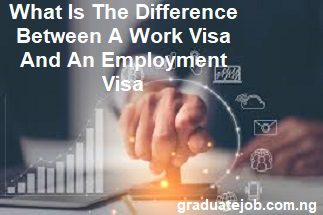Are you interested in knowing the major difference between a work his and an employment visa? Keep reading through to get informed.
We now live in a connected world, where the movement of individuals across borders in pursuit of employment opportunities keeps increasing.
Among the many legal mechanisms facilitating such endeavors, work visas and employment visas play an important role. Moreover, these terms can be interchanged, as they entail distinct nuances and serve some specific purposes.
In this article, we will look into the key difference between work and an employment visa that gives clarity on their concepts.
READ MORE: Canadian Work Sponsorship: Work Permit & Visa Process What Exactly Is a Visa?
A visa is an official endorsement that is stamped or attached to the passport by the authorities of a foreign country.
This signifies that the holder is eligible for all the requirements needed for that country for a specific period, purpose, and sometimes within geographic limitations.
Also, we have various types like tourist visas, business visas, student visas, work visas, etc. that are tailored to the specific needs of travelers.
Why Are Visas Important?
Visas are essential for countries to regulate the inflow of visitors and ensure security, prevent illegal immigration, maintain public health standards, and monitor the duration of stay in foreign visitors.
Moreover, it serves as a means for countries to boost relations, and tourism, promote and facilitate their business exchanges among nations.
What Is a Work Visa?
A work visa is major granted to individuals who intend to engage in employment within a specific country. Also, it authorizes them to work legally and is usually tied to a certain job or employer.
Work visas are designed to regulate the entry of foreign nationals into most countries for the sole purpose of employment.
These visas majorly come with restrictions that as being predetermined duration, type of work permitted, and sometimes geographical constraints within the country.
Applicants for work visas are always required to demonstrate their qualifications, job offer, and in some cases, evidence of labor market shortage in their employment in the host country.
Additionally, the issuance of work visas is contingent upon diverse factors which include the economic needs of the receiving nation, the competence of the applicant, and adherence to immigration laws and policies.
What Is an Employment Visa?
An employment visa is a broad category that has a wide range of activities beyond the work visa.
While employment visas do permit individuals to engage in employment activities, they can also facilitate other non-work related activities like business meetings, conferences, seminars, research or non-work activities, or volunteer work.
In essence, an employment visa gives authorization for individuals to stay in a foreign country within a period. Moreover, during this stay can participate in both work and non-related activities.
Employment visas give more flexibility compared to work visas in terms of the scope of permitted activities and the duration of stay.
They are always sought by individuals who wish to engage in a combination of professional and personal pursuits while residing in a foreign country.
Key Differences
Scope of Activities
As a work visa is majorly limited to work-related activities, an employment visa gives a broader range of engagements that are both work and non-work pursuits.
Duration And Flexibility
Employment visas can give greater flexibility in terms of the duration of stay and the various activities permitted compared to work visas, which are more specific and time-bound.
Employer Dependence
Work visas are always tied to the specific employer or job, whereas employment visas afford individuals more freedom to engage in diverse activities beyond a single job.
Application Requirements
The eligibility criteria and documentation required for obtaining a work visa versus an employment visa can vary based on the host country’s regulations and policies.
READ MORE: How to Get an Australian work visa Without an Agent
The Visa Application Process
Getting a visa is often a multisite process that involves submitting an application form, and supporting documents (such as passport photos, travel itinerary, and proof of funds).
Attending interviews (if required) and paying a visa fee. The processing time and requirements vary depending on the country issuing the visa and the visa type sought.
Global Impact Of Visas
Visas play an important role in the global landscape, influencing tourism, trade, education, and cultural exchange.
Also, they can either facilitate or hinder movement across borders, impacting individuals’ opportunities and connecting nations in a web of international relations.
The Future of Visas
As technology advances, some countries are exploring electronic visas (e-visas) and visa waiver programs to streamline the visa application process and boost tourism. These innovations aim to enhance security measures while promoting ease of travel-eligible individuals.
READ MORE: Difference Between Visa and Work Permit
Conclusion
While work visas and employment visas both facilitate legal entry and engagement in activities in a foreign country, they cater to distinct purposes and give various degrees of flexibility. Understanding the disparities between these two visa categories is important for individuals seeking opportunities abroad, enabling them to select the most suitable visa option based on their intended activities and duration of stay.






